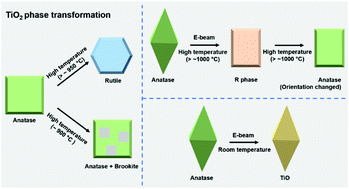Phase transformations among TiO2 polymorphs†
Abstract
Polymorphs widely exist in nature and synthetic systems and are well known to determine material properties. Understanding phase transformation mechanisms among polymorphs enables the design of structures and tuning of phases to tailor material properties. However, current understanding is limited due to the lack of direct observations of the structural evolution at the atomic scale. Here, integrating (semi) in situ transmission electron microscopy and density functional theory, we report atomic structural evolutions of phase transformation from anatase (A) to rutile (R), brookite (B), R-phase, and TiO. Besides the consistent paths with previous reports, we discover several unreported paths, including a [001] direction and (020) plane of anatase to [100]R and (0![[1 with combining macron]](https://www.rsc.org/images/entities/char_0031_0304.gif) 1)R of rutile, respectively, ([001]A||[100]R, (020)A||(0
1)R of rutile, respectively, ([001]A||[100]R, (020)A||(0![[1 with combining macron]](https://www.rsc.org/images/entities/char_0031_0304.gif) 1)R) and [001]A||[001]B, (020)A||(220)B. Density functional theory analysis elucidates atomic structural evolution during the processes and over 16% of Ti–O bonds break and reform during the processes with energy barriers of ∼0.7–1.0 eV per TiO2 formula unit. Under electron-beam irradiation, anatase particles transform into TiO2–R phase or TiO at high or room temperature, respectively. We also reveal the anisotropic nature of the electron-beam effect, which is seldom discussed: dependence of crystallographic orientation with respect to electron-beam irradiation direction. Understanding the atomic structural evolution sheds light on interpreting and controlling TiO2 polymorphs and intermediate structures for various applications. The revealed electron-beam effects in our work provide guidance for in situ transmission electron microscopy studies.
1)R) and [001]A||[001]B, (020)A||(220)B. Density functional theory analysis elucidates atomic structural evolution during the processes and over 16% of Ti–O bonds break and reform during the processes with energy barriers of ∼0.7–1.0 eV per TiO2 formula unit. Under electron-beam irradiation, anatase particles transform into TiO2–R phase or TiO at high or room temperature, respectively. We also reveal the anisotropic nature of the electron-beam effect, which is seldom discussed: dependence of crystallographic orientation with respect to electron-beam irradiation direction. Understanding the atomic structural evolution sheds light on interpreting and controlling TiO2 polymorphs and intermediate structures for various applications. The revealed electron-beam effects in our work provide guidance for in situ transmission electron microscopy studies.



 Please wait while we load your content...
Please wait while we load your content...
